Jiaming Guo
Policy Constraint by Only Support Constraint for Offline Reinforcement Learning
Mar 07, 2025Abstract:Offline reinforcement learning (RL) aims to optimize a policy by using pre-collected datasets, to maximize cumulative rewards. However, offline reinforcement learning suffers challenges due to the distributional shift between the learned and behavior policies, leading to errors when computing Q-values for out-of-distribution (OOD) actions. To mitigate this issue, policy constraint methods aim to constrain the learned policy's distribution with the distribution of the behavior policy or confine action selection within the support of the behavior policy. However, current policy constraint methods tend to exhibit excessive conservatism, hindering the policy from further surpassing the behavior policy's performance. In this work, we present Only Support Constraint (OSC) which is derived from maximizing the total probability of learned policy in the support of behavior policy, to address the conservatism of policy constraint. OSC presents a regularization term that only restricts policies to the support without imposing extra constraints on actions within the support. Additionally, to fully harness the performance of the new policy constraints, OSC utilizes a diffusion model to effectively characterize the support of behavior policies. Experimental evaluations across a variety of offline RL benchmarks demonstrate that OSC significantly enhances performance, alleviating the challenges associated with distributional shifts and mitigating conservatism of policy constraints. Code is available at https://github.com/MoreanP/OSC.
World-Consistent Data Generation for Vision-and-Language Navigation
Dec 09, 2024Abstract:Vision-and-Language Navigation (VLN) is a challenging task that requires an agent to navigate through photorealistic environments following natural-language instructions. One main obstacle existing in VLN is data scarcity, leading to poor generalization performance over unseen environments. Tough data argumentation is a promising way for scaling up the dataset, how to generate VLN data both diverse and world-consistent remains problematic. To cope with this issue, we propose the world-consistent data generation (WCGEN), an efficacious data-augmentation framework satisfying both diversity and world-consistency, targeting at enhancing the generalizations of agents to novel environments. Roughly, our framework consists of two stages, the trajectory stage which leverages a point-cloud based technique to ensure spatial coherency among viewpoints, and the viewpoint stage which adopts a novel angle synthesis method to guarantee spatial and wraparound consistency within the entire observation. By accurately predicting viewpoint changes with 3D knowledge, our approach maintains the world-consistency during the generation procedure. Experiments on a wide range of datasets verify the effectiveness of our method, demonstrating that our data augmentation strategy enables agents to achieve new state-of-the-art results on all navigation tasks, and is capable of enhancing the VLN agents' generalization ability to unseen environments.
Unveiling Hidden Details: A RAW Data-Enhanced Paradigm for Real-World Super-Resolution
Nov 21, 2024



Abstract:Real-world image super-resolution (Real SR) aims to generate high-fidelity, detail-rich high-resolution (HR) images from low-resolution (LR) counterparts. Existing Real SR methods primarily focus on generating details from the LR RGB domain, often leading to a lack of richness or fidelity in fine details. In this paper, we pioneer the use of details hidden in RAW data to complement existing RGB-only methods, yielding superior outputs. We argue that key image processing steps in Image Signal Processing, such as denoising and demosaicing, inherently result in the loss of fine details in LR images, making LR RAW a valuable information source. To validate this, we present RealSR-RAW, a comprehensive dataset comprising over 10,000 pairs with LR and HR RGB images, along with corresponding LR RAW, captured across multiple smartphones under varying focal lengths and diverse scenes. Additionally, we propose a novel, general RAW adapter to efficiently integrate LR RAW data into existing CNNs, Transformers, and Diffusion-based Real SR models by suppressing the noise contained in LR RAW and aligning its distribution. Extensive experiments demonstrate that incorporating RAW data significantly enhances detail recovery and improves Real SR performance across ten evaluation metrics, including both fidelity and perception-oriented metrics. Our findings open a new direction for the Real SR task, with the dataset and code will be made available to support future research.
Ex3: Automatic Novel Writing by Extracting, Excelsior and Expanding
Aug 16, 2024



Abstract:Generating long-term texts such as novels using artificial intelligence has always been a challenge. A common approach is to use large language models (LLMs) to construct a hierarchical framework that first plans and then writes. Despite the fact that the generated novels reach a sufficient length, they exhibit poor logical coherence and appeal in their plots and deficiencies in character and event depiction, ultimately compromising the overall narrative quality. In this paper, we propose a method named Extracting Excelsior and Expanding. Ex3 initially extracts structure information from raw novel data. By combining this structure information with the novel data, an instruction-following dataset is meticulously crafted. This dataset is then utilized to fine-tune the LLM, aiming for excelsior generation performance. In the final stage, a tree-like expansion method is deployed to facilitate the generation of arbitrarily long novels. Evaluation against previous methods showcases Ex3's ability to produce higher-quality long-form novels.
Prompt-based Visual Alignment for Zero-shot Policy Transfer
Jun 05, 2024



Abstract:Overfitting in RL has become one of the main obstacles to applications in reinforcement learning(RL). Existing methods do not provide explicit semantic constrain for the feature extractor, hindering the agent from learning a unified cross-domain representation and resulting in performance degradation on unseen domains. Besides, abundant data from multiple domains are needed. To address these issues, in this work, we propose prompt-based visual alignment (PVA), a robust framework to mitigate the detrimental domain bias in the image for zero-shot policy transfer. Inspired that Visual-Language Model (VLM) can serve as a bridge to connect both text space and image space, we leverage the semantic information contained in a text sequence as an explicit constraint to train a visual aligner. Thus, the visual aligner can map images from multiple domains to a unified domain and achieve good generalization performance. To better depict semantic information, prompt tuning is applied to learn a sequence of learnable tokens. With explicit constraints of semantic information, PVA can learn unified cross-domain representation under limited access to cross-domain data and achieves great zero-shot generalization ability in unseen domains. We verify PVA on a vision-based autonomous driving task with CARLA simulator. Experiments show that the agent generalizes well on unseen domains under limited access to multi-domain data.
Luban: Building Open-Ended Creative Agents via Autonomous Embodied Verification
May 24, 2024Abstract:Building open agents has always been the ultimate goal in AI research, and creative agents are the more enticing. Existing LLM agents excel at long-horizon tasks with well-defined goals (e.g., `mine diamonds' in Minecraft). However, they encounter difficulties on creative tasks with open goals and abstract criteria due to the inability to bridge the gap between them, thus lacking feedback for self-improvement in solving the task. In this work, we introduce autonomous embodied verification techniques for agents to fill the gap, laying the groundwork for creative tasks. Specifically, we propose the Luban agent target creative building tasks in Minecraft, which equips with two-level autonomous embodied verification inspired by human design practices: (1) visual verification of 3D structural speculates, which comes from agent synthesized CAD modeling programs; (2) pragmatic verification of the creation by generating and verifying environment-relevant functionality programs based on the abstract criteria. Extensive multi-dimensional human studies and Elo ratings show that the Luban completes diverse creative building tasks in our proposed benchmark and outperforms other baselines ($33\%$ to $100\%$) in both visualization and pragmatism. Additional demos on the real-world robotic arm show the creation potential of the Luban in the physical world.
Efficient Real-world Image Super-Resolution Via Adaptive Directional Gradient Convolution
May 11, 2024



Abstract:Real-SR endeavors to produce high-resolution images with rich details while mitigating the impact of multiple degradation factors. Although existing methods have achieved impressive achievements in detail recovery, they still fall short when addressing regions with complex gradient arrangements due to the intensity-based linear weighting feature extraction manner. Moreover, the stochastic artifacts introduced by degradation cues during the imaging process in real LR increase the disorder of the overall image details, further complicating the perception of intrinsic gradient arrangement. To address these challenges, we innovatively introduce kernel-wise differential operations within the convolutional kernel and develop several learnable directional gradient convolutions. These convolutions are integrated in parallel with a novel linear weighting mechanism to form an Adaptive Directional Gradient Convolution (DGConv), which adaptively weights and fuses the basic directional gradients to improve the gradient arrangement perception capability for both regular and irregular textures. Coupled with DGConv, we further devise a novel equivalent parameter fusion method for DGConv that maintains its rich representational capabilities while keeping computational costs consistent with a single Vanilla Convolution (VConv), enabling DGConv to improve the performance of existing super-resolution networks without incurring additional computational expenses. To better leverage the superiority of DGConv, we further develop an Adaptive Information Interaction Block (AIIBlock) to adeptly balance the enhancement of texture and contrast while meticulously investigating the interdependencies, culminating in the creation of a DGPNet for Real-SR through simple stacking. Comparative results with 15 SOTA methods across three public datasets underscore the effectiveness and efficiency of our proposed approach.
Real-Time 4K Super-Resolution of Compressed AVIF Images. AIS 2024 Challenge Survey
Apr 25, 2024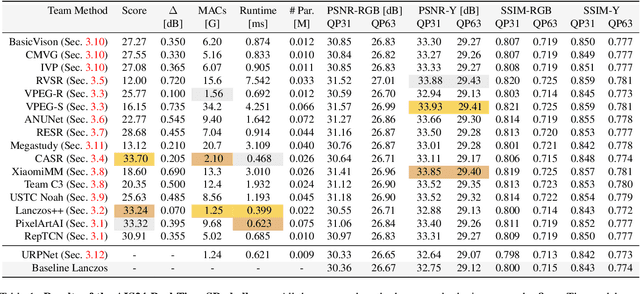

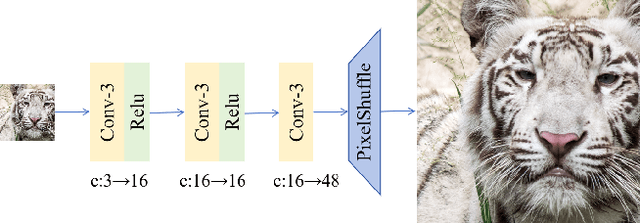
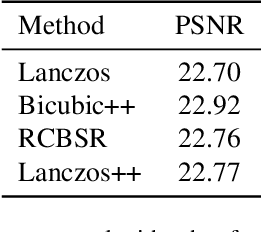
Abstract:This paper introduces a novel benchmark as part of the AIS 2024 Real-Time Image Super-Resolution (RTSR) Challenge, which aims to upscale compressed images from 540p to 4K resolution (4x factor) in real-time on commercial GPUs. For this, we use a diverse test set containing a variety of 4K images ranging from digital art to gaming and photography. The images are compressed using the modern AVIF codec, instead of JPEG. All the proposed methods improve PSNR fidelity over Lanczos interpolation, and process images under 10ms. Out of the 160 participants, 25 teams submitted their code and models. The solutions present novel designs tailored for memory-efficiency and runtime on edge devices. This survey describes the best solutions for real-time SR of compressed high-resolution images.
The Ninth NTIRE 2024 Efficient Super-Resolution Challenge Report
Apr 16, 2024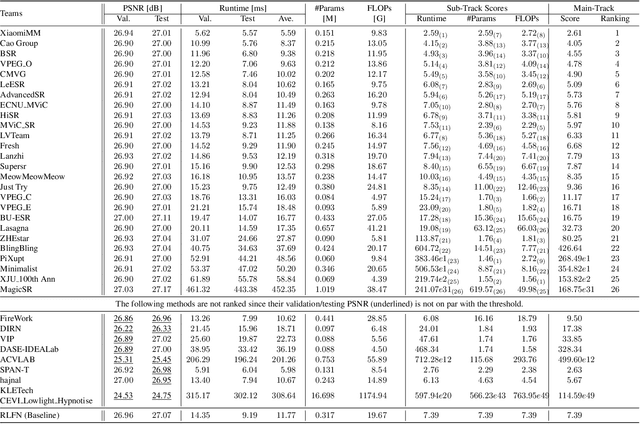
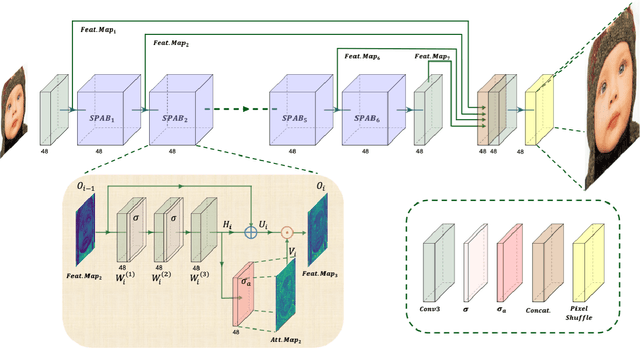


Abstract:This paper provides a comprehensive review of the NTIRE 2024 challenge, focusing on efficient single-image super-resolution (ESR) solutions and their outcomes. The task of this challenge is to super-resolve an input image with a magnification factor of x4 based on pairs of low and corresponding high-resolution images. The primary objective is to develop networks that optimize various aspects such as runtime, parameters, and FLOPs, while still maintaining a peak signal-to-noise ratio (PSNR) of approximately 26.90 dB on the DIV2K_LSDIR_valid dataset and 26.99 dB on the DIV2K_LSDIR_test dataset. In addition, this challenge has 4 tracks including the main track (overall performance), sub-track 1 (runtime), sub-track 2 (FLOPs), and sub-track 3 (parameters). In the main track, all three metrics (ie runtime, FLOPs, and parameter count) were considered. The ranking of the main track is calculated based on a weighted sum-up of the scores of all other sub-tracks. In sub-track 1, the practical runtime performance of the submissions was evaluated, and the corresponding score was used to determine the ranking. In sub-track 2, the number of FLOPs was considered. The score calculated based on the corresponding FLOPs was used to determine the ranking. In sub-track 3, the number of parameters was considered. The score calculated based on the corresponding parameters was used to determine the ranking. RLFN is set as the baseline for efficiency measurement. The challenge had 262 registered participants, and 34 teams made valid submissions. They gauge the state-of-the-art in efficient single-image super-resolution. To facilitate the reproducibility of the challenge and enable other researchers to build upon these findings, the code and the pre-trained model of validated solutions are made publicly available at https://github.com/Amazingren/NTIRE2024_ESR/.
Assessing and Understanding Creativity in Large Language Models
Jan 23, 2024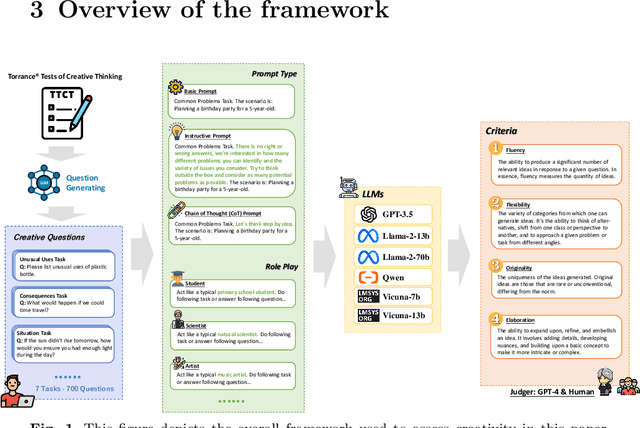
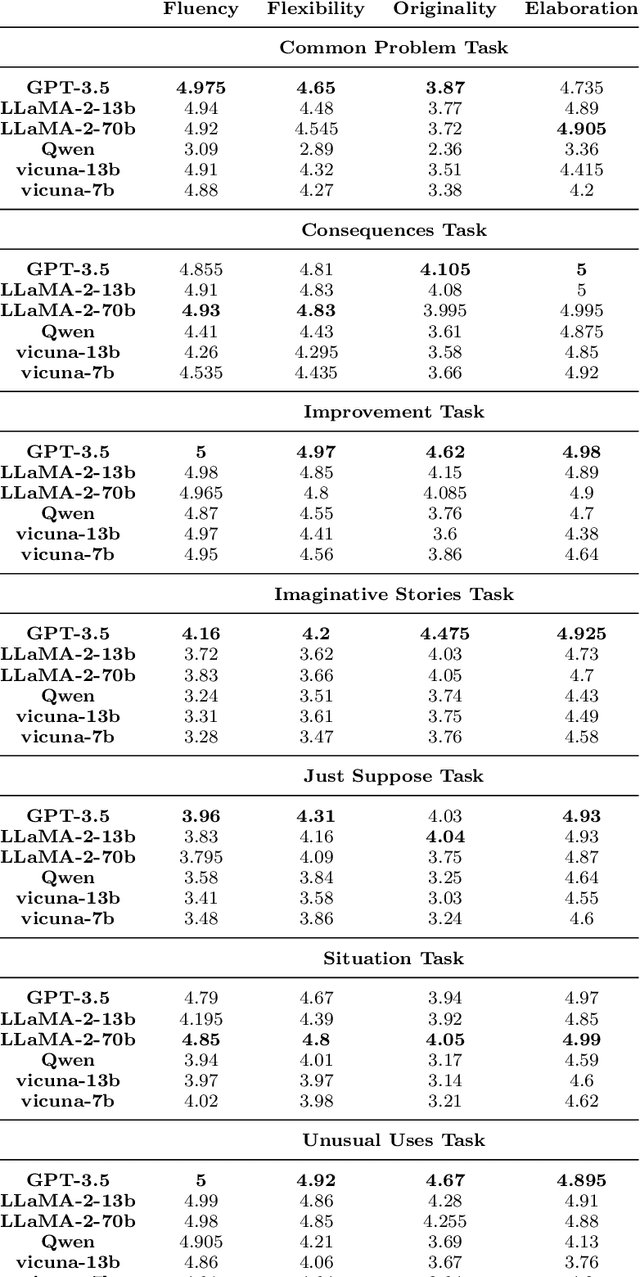
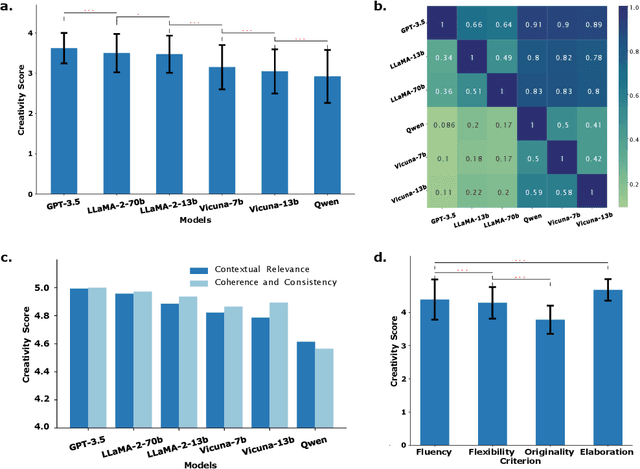
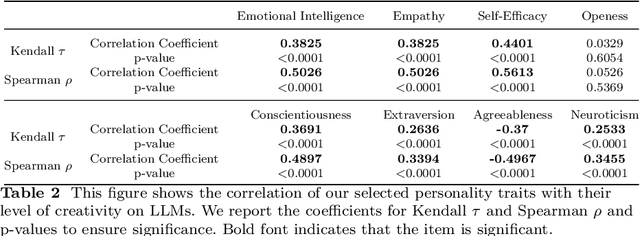
Abstract:In the field of natural language processing, the rapid development of large language model (LLM) has attracted more and more attention. LLMs have shown a high level of creativity in various tasks, but the methods for assessing such creativity are inadequate. The assessment of LLM creativity needs to consider differences from humans, requiring multi-dimensional measurement while balancing accuracy and efficiency. This paper aims to establish an efficient framework for assessing the level of creativity in LLMs. By adapting the modified Torrance Tests of Creative Thinking, the research evaluates the creative performance of various LLMs across 7 tasks, emphasizing 4 criteria including Fluency, Flexibility, Originality, and Elaboration. In this context, we develop a comprehensive dataset of 700 questions for testing and an LLM-based evaluation method. In addition, this study presents a novel analysis of LLMs' responses to diverse prompts and role-play situations. We found that the creativity of LLMs primarily falls short in originality, while excelling in elaboration. Besides, the use of prompts and the role-play settings of the model significantly influence creativity. Additionally, the experimental results also indicate that collaboration among multiple LLMs can enhance originality. Notably, our findings reveal a consensus between human evaluations and LLMs regarding the personality traits that influence creativity. The findings underscore the significant impact of LLM design on creativity and bridges artificial intelligence and human creativity, offering insights into LLMs' creativity and potential applications.
 Add to Chrome
Add to Chrome Add to Firefox
Add to Firefox Add to Edge
Add to Edge